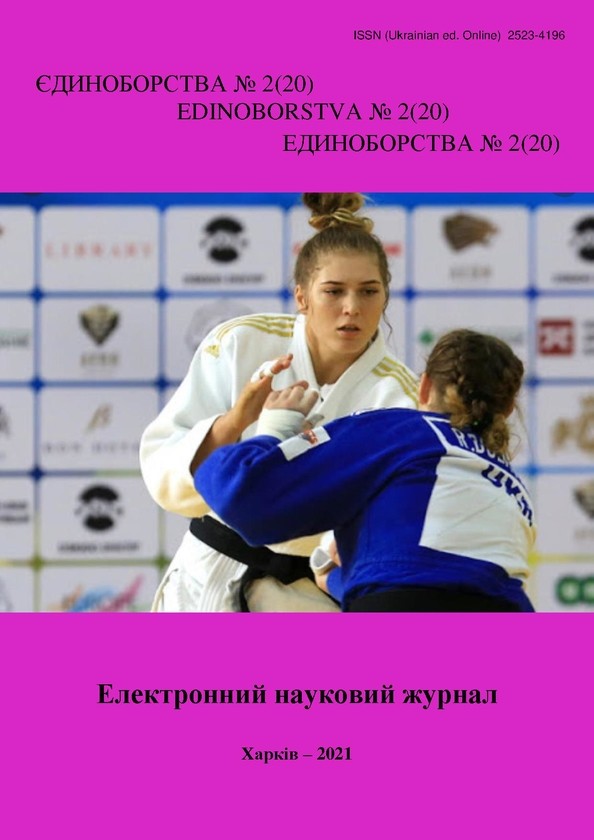Efficiency of application of wrestling means of game and competitive nature in physical education of lyceum students with enhanced military and physical preparation
DOI:
https://doi.org/10.15391/ed.2021-2.01Keywords:
lesson, physical culture, military, lyceum, means, wrestlingAbstract
Purpose: to determine the effectiveness of use the wrestling means of game and competitive nature in physical education of lyceum students
with enhanced military and physical preparation. Material and methods. There were used methods of theoretical analysis and generalization of scientific literature, pedagogical observation, pedagogical experiment, methods of mathematical statistics. The study involved 49 students of 10th
grade of the Lviv State Lyceum with enhanced military and physical preparation named after Heroes of Kruty, who were divided into control (KG, n=25) and experimental (EG, n=24) groups. The first was engaged during the semester in the traditional curriculum of physical culture, the second - in the
author's program with an emphasis on the use of wrestling means of game and competition nature. Results: the professionalism of a military man requires versatile personal development already starting from the level of secondary education. An important component in the skill structure of the
future defender of the Fatherland is the level of his physical preparedness. Today in lyceums with enhanced military and physical preparation there is a need to update the material on the subject of «physical culture» in the direction of finding new sports activities that on the one hand would be
aimed at formation the necessary skills of future military man and on the other - develop important physical qualities for this profession. It is determined that positive changes also take place in various aspects of development and preparedness of participants in the studied groups. The average total
increase in functional tests in EG participants was 5,7 %, and in CG pupils – only 2,0 %, and most of the changes in both groups were significant (p≤0,05-0,001). There were significant changes in the level of physical fitness of the participants in the pedagogical experiment. Thus, in EG pupils the total
average increase of its level was 24,5 %, and in the studied of CG – only 8,9 %. According to the preparedness indices, the results also increased in both groups. In EG, the total average increase in index indicators was 4,1 %, while in CG – 1,6 % (p≤0,05–0,001), except for indicators of CG speed
index and endurance index in EG (p>0,05). Conclusions. During the pedagogical experiment, in fact, for all groups of indicators, the author's program on physical culture with the use of wrestling means turned out to be more effective in comparison with the traditional program for students of 10th
graders of the Lviv State Lyceum with enhanced military and physical preparation named after Heroes of Kruty. Positive changes were recorded in the level of functional capabilities of the participants of the studied groups. The average total increase was 5,7 % in the participants of the
experimental group, and only 2,0 % in the students of the control group. Significant changes were also in the students’ physical fitness, the students of the experimental group had an overall average total increase in its level of 24,5 %, and the participants of the control group - only 8,9 %.
References
Балушка, Л., Хіменес, Х., Окопний, А., Пітин, М., Согор, О., & Ткач, Ю. (2020). Динаміка підготовленості учнів ліцею з посиленою військово-фізичною підготовкою під впливом використання засобів боротьби. Теорія та методика фізичного виховання, 20(3), 165-173.
Волков, Л. В. (2018). Вікові особливості розвитку основних компонентів координаційної та спеціальної підготовленості підлітків і юнаків у процесі багаторічних занять вільною боротьбою. Науковий часопис Нац. пед. ун-ту імені М. П. Драгоманова. Серія 15, Науково-педагогічні проблеми фізичної культури (фізична культура і спорт), 8(102), 30-36.
Власюк, О. (2011). Розвиток фізичних якостей дітей 11-13 років на уроках фізичної культури засобами скелелазіння. Молода спортивна наука України, 15, 32-37.
Кізло, Л., Купієнко, О., & Федак, С. (2011). Особливості розвитку вольових якостей курсантів засобами фізичної підготовки і спорту (з використанням елементів рукопашного бою). Молода спортивна наука України, 7,2, 83-89.
Круцевич Т. (2005). Нормування результатів фізичної підготовленості дітей, підлітків та юнацтва методом індексів. Спортивний вісник Придніпров'я, 2, 22-26.
Платонов, В. Н. (2015). Система подготовки спортсменов в олимпийском спорте. Общая теория и ее практические приложения: учебник [для тренеров]. Олимпийская литература, Киев.
Шандригось, В. І., Яременко, В. В., Латишев, М. В., & Первачук, Р. В. (2020). До питання удосконалення програмно-методичного забезпечення з вільної боротьби. Єдиноборства, 2(16),74-85.
Черенщиков, А. Г. (2013). Экспериментальная программа по физической культуре на основе углубленного изучения борьбы самбо. Проблемы физической культуры и спорта в новом тысячелетии, 133-6.
Destani, Fitni, Hannon, James C., Podlog, Leslie, & Brusseau, Timothy A. (2014). Promoting Character Development through Teaching Wrestling in Physical Education. Journal of Physical Education, Recreation & Dance, 85, 5, 23-29.
Ilnytskyy, I., Okopnyy, A., Palatnyy, A., Pityn, M., Kyselytsia, O., & Zoriy Y. (2018). Use of boxing to improve the physical education content in lyceums with intensive military and physical training. Journal of Physical Education and Sport (JPES), 18(1), 262-269. doi:10.7752/jpes.2018.01035
Johnson, J., & Hyo, & Jung Kang (2018). Hapkido research trends: a review. Ido Movement for. Journal of Martial Arts Anthropology,18,3, 42-50, doi: 10.14589/ido.18.3.7.
Pityn, M., Briskin, Yu., Zadorozhna, O. (2013). Features of theoretical training in combative sports. Journal of Physical Education and Sport, 13(2), 2, 195-198. doi:10.7752/jpes.2013.02032
Pityn, M., Okopnyy, A., Tyravska, O., Hutsul, N., & Ilnytsky, I. (2017). Dynamic of indexes of technical and tactical actions of qualified kickboxer individual fighting style. Journal of Physical Education and Sport (JPES), 17(3), 1024-1030. doi:10.7752/jpes.2017.s3157
Prystupa, E., Okopnyy, A., Hutsul, N., Khimenes, Kh., Kotelnyk, A., Hryb, I., & Pityn, M. (2019).
Development of special physical qualities skilled kickboxers various style of competitive activity. Journal of Physical Education and Sport, 19(2), 273-80. doi:10.7752/jpes.2019.s2041.
Wei-Ting, & Hsu, Min, Pan (2019). Development and Validation of the Teacher RISE Support Scale in Physical Education. Journal of Teaching in Physical Education. 38:4, 286-295.
Yockey J. (2005). Wrestling: An elementary approach. Teaching Elementary Physical Education, 17, 14-7.













